- Home
- Classes
- Physics 134 – Observational Astrophysics – Fall 2022
- Physics 6B – Spring 2015
- Physics 134 – Observational Astrophysics – Fall 2020
- Symmetry & Aesthetics in Contemporary Physics
- Physics 128 – Senior Lab – Fall 2016
- INT 184 – PL Interdisciplinary Honors Seminar – Weapons of Mass Destruction – Spring 2013
- Physics 150 – Modern Design and Fab – Fall 2019
- Physics 134 – Observational Astrophysics – Fall 2019
- Physics 2 – Fall 2013
- Physics 3 – Fall 2016
- Physics 4 – Winter 2020
- Astro 1 – Fall 2020
- Physics 4 – Winter 2023
- Physics 141 – Optics – Spring 2019
- Physics 145L – Astrophysics Research
- Physics 199 – Independent Research
- Projects
- Facilities
- People
- Net
- Outreach
- Misc
- Papers
Extrasolar Travelers
Preparing the first extrasolar travelers:
Nematodes and Tardigrades – Real Interstellar Passengers
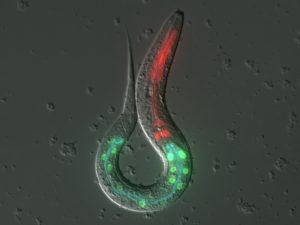
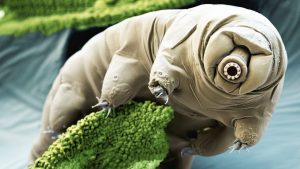
A collaboration with the lab of Professor Joel Rothman in the
Department of Molecular and Cellular Developmental Biology
Page created by Dr. Jatila van der Veen, Project Scientist in the Lubin Lab.
Publications
Interstellar Biology – Propagating Life Outside the Solar System
Lantin et al Acta Astronautica 190,261, Jan 2022
https://www.sciencedirect.com/science/article/pii/S0094576521005518
https://arxiv.org/abs/2110.13080
www.centauri-dreams.
UCSB Press Release – Sending Life to the Stars Jan 2022
https://www.news.ucsb.edu/2022/020502/sending-life-stars
There are a large number of secondary links to our paper and UCSB press release on the internet
BBC Science Focus interview
https://www.sciencefocus.com/space/tardigrades-first-interstellar-space-travellers/
Nematode C, elegans Survival at 400,000g
https://pubmed.ncbi.nlm.nih.gov/29746159/
Work on Impact Survival on Tardigrades – Univ Kent
https://www.liebertpub.com/doi/full/10.1089/ast.2020.2405
In the early days of space exploration in the 20th Century, before humans ever ventured above the atmosphere, animals were launched. Fruit flies were the first living beings to be launched in 1947, followed by mice, monkeys, and dogs in the late 1940’s and early 1950s. Laika, a stray dog from the streets of Moscow, was the first space dog launched on a Sputnik spacecraft in 1957.
 |
Sadly, the early days of space flight were rather stressful for the animals involved. Many of the early animals, such as Leika, died during the flight or shortly after return.
In the 1960s NASA had an extensive program to train chimps for space flight. Ham was the first space chimp launched by NASA in 1961 who survived his mission. Enos, the second NASA space chimp to survive his mission, was the first to orbit the Earth. The survival rate of the first space travelers increased with more experience, until humanity was ready to launch the first humans into space. Left: Leika, the first Russian space dog. Source: Laika – first dog in space |
The first human to orbit the Earth was the Russian cosmonaut Yuri Gagarin, in April of 1961, followed by NASA’s Alan Shepard in May of 1961 and John Glenn in February, 1962.
 |
 |
 |
| Soviet Cosmonaut Yuri Gagarin | American Astronaut Alan Shepard | American Astronaut John Glenn |
The sacrifices of the brave space animals led to NASA’s successful Mercury and Gemini missions, which orbited the Earth and Moon. Finally the Apollo missions, beginning with Apollo 11 in 1969, made six successful manned Moon landings. During the Apollo missions the astronauts explored different regions of the lunar terrain, planted seismometers, magnetometers, gravimeters, and heat-flow probes, took pictures and movies, and brought back samples of lunar rocks and regolith (the lunar soil).
 |
| Apollo 11 Moon Landing |
While NASA is currently working on sending more humans to the Moon, and eventually to Mars, scientists of Project Starlight at the University of California, Santa Barbara, are working on the future of interstellar space travel – sending probes, and eventually people, out of the Solar System and into interstellar space to explore the Galaxy. Before we ever have the technology to send humans, we plan to send tiny animals that have been shown to tolerate extreme environments of cold, heat, the vacuum of space, extreme dehydration, high accelerations (tens of thousands of g’s), and high doses of radiation – and survive unscathed. These hearty creatures are Caenorhabditis elegans, or C. elegans for short – a ubiquitous species of nematode found in compost piles and soil samples world-wide, and the water-dwelling micro-animals called Tardigrades, otherwise known as Water Bears. These tiny creatures have already been in space during the Space Shuttle program and have flown on the International Space Station.
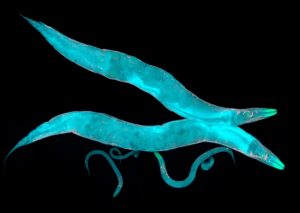 |
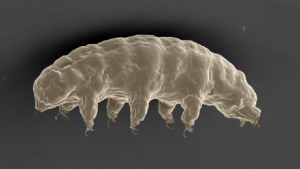 |
| C. elegans fluorescing cyan when exposed to violet light | electron micrograph of a tardigrade |
The biggest problem in traveling outside our solar system is the extreme distance. The Voyager space probes, launched in the 1970s, took over forty years to reach the edge of our solar system! At these speeds it will take the Voyagers around 80,000 years to reach our nearest galactic neighbors in the Alpha Centauri System, 4.2 light years away. Even with faster technology of the Starlight program, humans could not reach our nearest exoplanets in one lifetime. They would have to travel in stasis, like the fictional passengers in the movie Passengers.
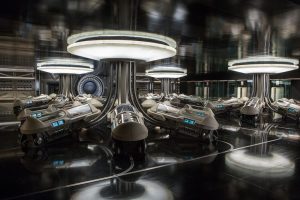
C. elegans and tardigrades have a number of traits that make them ideal passengers for long interstellar voyages. Besides being microscopic, and thus conveniently fitting on our first interstellar wafer craft, they can be frozen and put into a state of anhydrobiosis, meaning they can be dehydrated and put into suspended animation. When they are re-hydrated, they wake up as good as new!

Image source: Science Daily Credit: 2016 Sae Tanaka, Hiroshi Sagara, Takekazu Kunieda.
Thus, before we can consider sending humans out into the galaxy, we need to first understand how to put living creatures into a condition of stasis from which they can successfully be awakened when they arrive at their destination. This is a HUGELY complex problem, so we are starting very small: with C. elegans and tardigrades, ideal animals that have been put into stasis and successfully revived.
Best-mapped genome in the galaxy! C. elegans are ideal for experimentation because their complete genome has been mapped, and other than gender, there is no genetic variation from parent to offspring – unlike humans and other complex animals. They have rather complex behavior for animals with just under 1,000 cells in their tiny bodies. They have rather sophisticated nervous systems for such simple creatures, and they can learn and unlearn behaviors. They are aware of their environment, they can learn to respond to stimuli such as good food to eat and bad smells to avoid. They come in two “genders” – male and hermaphrodite (male and female in one body), and can reproduce 300 offspring in around 2 days. They can be frozen indefinitely and be revived in a few minutes, retaining their pre-freeze memories, and they can survive being dehydrated for decades. And they are conveniently small: 100 million adults can fit in one teaspoon!
Hardy Extremophiles! Well… Tardigrades are not exactly extremophiles because they don’t thrive in harsh conditions, but they are more tolerant of extremes of heat, cold, vacuum, and high pressure than most animals, thus they are excellent candidates for interstellar travel. They can survive extreme temperatures from 1K (one degree above absolute zero) to 400 K (the temperature of boiling water at sea level) and they can survive extreme dehydration, drying out to 1% water by weight, but reviving upon re-hydration as if nothing happened. They can withstand extreme radiation, 1,000 times more than humans can. They can survive in suspended animation for over 100 years, and they can survive extremes in pressure, from the vacuum of space to 10 atmospheres. This behavior has led to the saying, “Water Bear don’t care.”
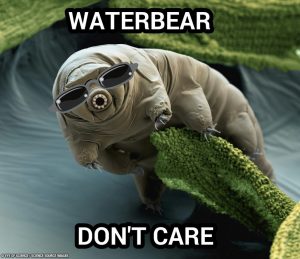
Some fast facts about the Nematodes C. elegans and the Tardigrades H. dujardini
| Nematodes Caenorhabditis elegans | Tardigrades Hypsibius dujardini |
|---|---|
| Phylum: Nematoda | Phylum: Tardigrada; AKA water bears, space bears, moss piglets |
| genus: Caenorhabditis | genus: Hypsibius |
| species: C. elegans | species: H. dujardini |
| Sexes: Adults come in male (~2%) and hermaphrodite (self-fertilizing – ~ 98%) | Sexes: male and female, though sometimes reproduction occurs by meiotic parthenogenesis |
| Size: larvae: 0.25mm; adults: 1.0 mm | Size: 0.1 to 1.0 mm long |
| Dauer phase: dehydrated, non-reproducing | Tun phase: extremely dehydrated, non-reproducing |
| Habitat: found world-wide in soil, decaying fruit, compost piles | Habitat: found world-wide in freshwater lakes, streams, rivers, associated with algae and vascular plants, from Antarctic to tropical regions |
| Food: bacteria, algae | Food: bacteria, algae, protozoa, bryophytes, fungi, decaying plant matter, nematodes, rotifers, and smaller tardigrades. |
| Life cycle: 3 days at 250C from egg to reproductive adult; adult lives another 7 – 10 days for a total lifespan of ~ 2 weeks | Life cycle: 4 days gestation; lifespan in the wild estimated at 4 to 12 years, less in captivity |
| Genome of C. elegans has been completely mapped | Genome of H. dujardini has been completely mapped |
| Fossil record: Sparse, due to soft body with no hard parts. Earliest record of marine nematodes: 470 My ago | Fossil record: 530 My ago, in the Cambrian Period |
Physiology: less than 1000 cells, 302 neurons
|
Physiology: up to 40,000 cells
|
| Most fascinating feature: They can learn, and they have memory | Most Fascinating Known Features:
|
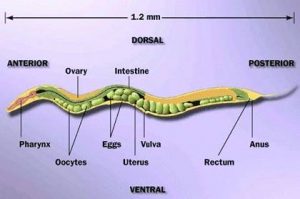 |
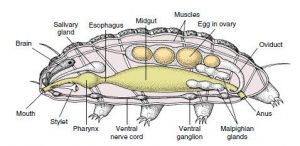 |
Sources for above information:
- Worm Fact Sheet, at Canada’s Michael Smith Genome Sciences Centre
- Goldstein Lab at UNC Chapel Hill , and C. elegans and Tardigrade pages on Wikipedia.
- Animal Diversity Web pages on C. elegans and H. dujardini
Scientists in the Rothman Lab at UCSB are studying the behavior of these tiny subjects in the lab to better understand their behavior and needs before sending them into space. Meanwhile, scientists in the Lubin Lab, in the Starlight Program, are figuring out what kind of tiny chambers to design for them, where to place them on our wafer sats, and how to wake them up at various points in the journey and remotely observe their behavior.
Current and near-term experiments in the biology lab include:
- Assessing their survival under conditions mimicking launch and transport
- Determining their best suspended animation state for survival at high g-forces
- Culturing and imaging them, in the lab and developing the technology to image them while they are on board the wafer craft
- Developing the housing that will shield the C. elegans from radiation in space without adding much mass to the wafer craft
- Discovering whether memories are preserved after being frozen and accelerated
After launch, we want to study their metabolism, DNA replication, cell division, development into adulthood, and procreation. Will the first generations born near another star be the same as those in our solar system? Will they preserve the terrestrial C. elegans’ behaviors? Will the stress of spaceflight affect their life spans?
As for the question of contamination from Earth, these nematodes and tardigrades are completely benign to human and animal life on Earth. Unlike some other varieties of nematode, C. elegans has not been known to trigger any intestinal or other problems.
Here are 3D images of a male C. elegans (left) and a tardigrade (right). To get the 3D effect, you need to view these images with red/cyan glasses. (If you don’t have any, they are readily available from DHGate.com or from Amazon.com for low prices.)
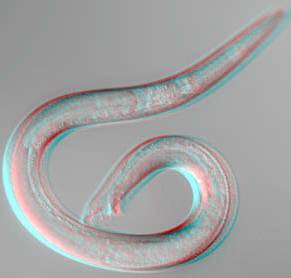 Source of original file for this male C. elegans image Amazon S3 publicly available files. |
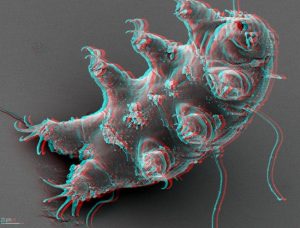 Source of original file for this electron micrograph of a tardigrade is Ralph O. Schill, of the European Space Agency. |
Will they survive? Could they take root on another planet with water? Maybe. How did they get to Earth in the first place? Maybe they came here from some other solar system!
Here is a short video taken with an iPhone5 in the lab, showing C. elegans in white light, eating algae food and making sinusoidal tracks. Next we filmed them in different colored light, which causes parts of their body to fluoresce different colors. In violet light, they fluoresce cyan (aqua) and the lining of their gut shows up. In green light they fluoresce red, and the muscles of their body walls show up.
And here is a cool movie about Tardigrades from the Goldstein Lab at the University of North Carolina, Chapel Hill, which appeared
on NPR’s Science Friday:
Some additional references for C.elegans and tardigrades:
For more information about research on C. elegans at UCSB, please visit The Rothman Lab
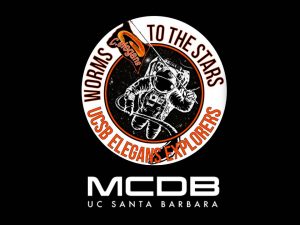
Logo by Peter Allen, UCSB Engineering Department